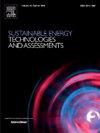Enhancing biodiesel cetane number prediction: Comparative study of neural network architectures with integer and conformable transfer functions
IF 7.1
2区 工程技术
Q1 ENERGY & FUELS
Sustainable Energy Technologies and Assessments
Pub Date : 2025-02-18
DOI:10.1016/j.seta.2025.104241
引用次数: 0
Abstract
The precise prediction of biodiesel properties, particularly cetane number, presents an ongoing challenge due to the complexity of its composition and combustion behavior. Consequently, this study is dedicated to enhancing the prediction of biodiesel properties by employing integer and conformable transfer functions in the hidden layer of artificial neural networks. The ELU, SWISH, SOFTPLUS, LOGSIG, and TANSIG functions and their conformability were evaluated to predict the cetane number. A dataset of experimental observations was obtained, encompassing 16 input variables. Based on molar ratios, these variables represent the Fatty Acid Methyl Esters (FAME), ranging from C8 to C24. The experimentation incorporated a slope-intercept test with a confidence level of 99% as an initial filter for model selection, demonstrating a commitment to improving biodiesel property prediction. The findings uncovered that a conformable artificial neural network (CANN) model featuring a 16:4:1 architecture and employing the CTANSIG transfer function in the hidden layer and linear function in the output layer achieved outstanding performance. It exhibited a strong correlation coefficient of 0.9384 and RMSE 0.0408, effectively balancing precision and computational efficiency. Additionally, this study streamlined ANN models using conformable transfer functions, thereby reducing complexity and enhancing predictive accuracy.
求助全文
约1分钟内获得全文
求助全文
来源期刊

Sustainable Energy Technologies and Assessments
Energy-Renewable Energy, Sustainability and the Environment
CiteScore
12.70
自引率
12.50%
发文量
1091
期刊介绍:
Encouraging a transition to a sustainable energy future is imperative for our world. Technologies that enable this shift in various sectors like transportation, heating, and power systems are of utmost importance. Sustainable Energy Technologies and Assessments welcomes papers focusing on a range of aspects and levels of technological advancements in energy generation and utilization. The aim is to reduce the negative environmental impact associated with energy production and consumption, spanning from laboratory experiments to real-world applications in the commercial sector.
 求助内容:
求助内容: 应助结果提醒方式:
应助结果提醒方式:


